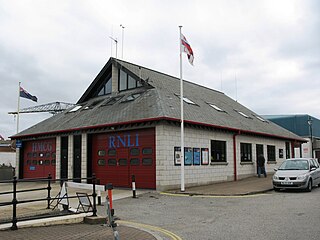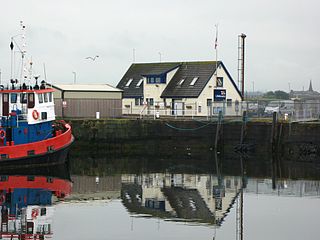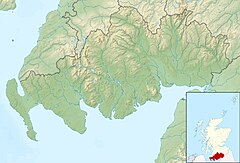
Falmouth Lifeboat Station is the base for Royal National Lifeboat Institution (RNLI) search and rescue operations at Falmouth, Cornwall in the United Kingdom. The first lifeboat was stationed in the town in 1867 and the present station was opened in 1993. It operates a Severn Class all-weather Lifeboat (ALB) and an Atlantic 85 inshore lifeboat (ILB).

Fowey Lifeboat Station is the base for Royal National Lifeboat Institution (RNLI) search and rescue operations at Fowey on the south coast of Cornwall in the United Kingdom. The first lifeboat was stationed in the area in 1859 and the present station was opened in 1997. It operates a Trent Class all weather boat (ALB) and a D class (IB1) inshore lifeboat (ILB).

Appledore Lifeboat Station is the base for Royal National Lifeboat Institution (RNLI) search and rescue operations at Appledore, Devon, England. The first lifeboat was stationed in the town in 1825 and the present station was opened in 2001. It operates a Tamar-class all-weather boat (ALB) and an Atlantic 85 B Class inshore lifeboat (ILB).

St Ives Lifeboat Station is the base for Royal National Lifeboat Institution (RNLI) search and rescue operations at St Ives, Cornwall in the United Kingdom. The first lifeboat was built for the town in 1840 and the present boathouse was opened in 1994. It operates a Shannon-class All-weather boat (AWB) and a D-class (IB1) inshore lifeboat (ILB).

Exmouth Lifeboat Station is the base for Royal National Lifeboat Institution (RNLI) search and rescue operations at Exmouth, Devon, England. The first lifeboat was stationed in the town in 1803 and the present station was opened in 2009. In 2014 a new Shannon-class 25-knot all-weather boat (ALB) went on station. Also operated is a D-class (IB1) inshore lifeboat (ILB).

Torbay Lifeboat Station is the base for Royal National Lifeboat Institution (RNLI) search and rescue operations at Brixham, Devon in England. Brixham Lifeboat Station was opened in 1866 but since 1924 has been known as 'Torbay'. Since 2005 it has operated a Severn-class all-weather lifeboat (ALB) together with a D-class (IB1) inshore lifeboat (ILB).

Llandudno Lifeboat Station is located in the town and seaside resort of Llandudno, sitting on the Creuddyn peninsula, in Conwy County Borough, North Wales.

Southwold Lifeboat Station is an RNLI operated lifeboat station located in the town of Southwold in the English county of Suffolk.

Lowestoft Lifeboat Station is a Royal National Lifeboat Institution (RNLI) operated lifeboat station in the town of Lowestoft in the English county of Suffolk. The station is located at the mouth of Lowestoft's outer harbour on the South pier. It is one of the oldest lifeboat stations in the United Kingdom, having been established in 1801.

Walton and Frinton Lifeboat Station is a Royal National Lifeboat Institution (RNLI) station located in the town of Walton-on-the-Naze in the English county of Essex.

Clovelly Lifeboat Station, serving the North Devon village of Clovelly and surrounding coastal waters, is run by the Royal National Lifeboat Institution (RNLI). It was established in 1870. The station is flanked by Appledore to the northeast and Bude to the southwest.

Penzance Lifeboat Station was the base for Royal National Lifeboat Institution (RNLI) operations in Mount's Bay in Cornwall, United Kingdom. The first lifeboat to be placed at Penzance was in 1803 but a permanent station was not established until 1853. It closed in 1917 by which time the Penlee Lifeboat Station had been established.

Plymouth Lifeboat Station is the base for Royal National Lifeboat Institution (RNLI) search and rescue operations at Plymouth in England. The first lifeboat was stationed in the city in the early 1800s. The station moved to its present site at Millbay Docks in 1992, a Grade II-listed three-storey tower. Since 2003 it has operated a Severn-class all-weather boat (ALB) along with an B-class Atlantic inshore lifeboat (ILB).

Troon Lifeboat Station is the base for Royal National Lifeboat Institution (RNLI) lifeboats at Troon in South Ayrshire, Scotland. It opened in 1871 and operates both all-weather and inshore lifeboats.

Campbeltown Lifeboat Station is the base for Royal National Lifeboat Institution (RNLI) lifeboat at Campbeltown in Argyll, Scotland. It opened in 1861 and today operates both inshore and all-weather lifeboats.

Ballycotton Lifeboat Station is the base for Royal National Lifeboat Institution (RNLI) lifeboat at Ballycotton in County Cork, Ireland. It opened in 1858 and continues to operate today. Its most notable rescue was the crew of the Daunt Rock lightship in 1936 which kept the crew at sea for the best part of three days.
Kilmore Quay Lifeboat Station is the base for Royal National Lifeboat Institution (RNLI) lifeboat at Kilmore Quay in County Wexford, Ireland. It was known as just Kilmore Lifeboat Station until 1986.

Rosslare Harbour Lifeboat Station is the base for a Royal National Lifeboat Institution (RNLI) lifeboat at Rosslare Harbour in County Wexford, Ireland.

Donaghadee Lifeboat Station is located at the Parade, in Donaghadee, a harbour town approximately 19 miles (31 km) east of Belfast, on the east coast of County Down, Northern Ireland

Helvick Head Lifeboat Station is the base for a Royal National Lifeboat Institution (RNLI) inshore lifeboat at Helvick in County Waterford, Ireland.
























